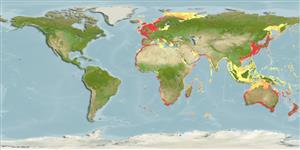>
Zeiformes (Dories) >
Zeidae (Dories)
Eponymy: Derived from zaeus, an ancient Greek name for this fish dating back to Pliny’s Natural History. [...] There are many alternative names for this fish and almost as many theories as to the origin of the name. [...] (Ref. 128868), visit book page.
More on author: Linnaeus.
Environment: milieu / climate zone / depth range / distribution range
বাস্তুসংস্থান
সামুদ্রিক; ঈষৎ লোনা সমুদতলে ভাসমান বেনথোপেলাজিক; মহাসাগরে বিচরনক্ষম (Ref. 35388); গভীরতার পরিসীমা 5 - 400 m (Ref. 9563), usually 50 - 150 m (Ref. 4968). Temperate; 75°N - 49°S, 17°W - 177°E (Ref. 54935)
Worldwide in distribution. Eastern Atlantic: Norway to South Africa, also the Mediterranean and Black Sea. Western Pacific: Japan, Korea, Australia and New Zealand. Also known from the Indian Ocean.
Length at first maturity / আকৃতি / ওজন / Age
Maturity: Lm 35.1, range 29 - 35 cm
Max length : 90.0 cm TL পুরুষ/ লিঙ্গ অনিধর্ারিত ; (Ref. 6953); common length : 40.0 cm TL পুরুষ/ লিঙ্গ অনিধর্ারিত ; (Ref. 6953); সবের্াচ্চ প্রকাশিত ওজন : 8.0 kg (Ref. 35388); সর্বোচ্চ উলি্ল্লখিত বয়স : 12 বৎসর (Ref. 5377)
পৃষ্ঠীয় কাঁটা (মোট ) : 9 - 11; পৃষ্ঠীয় নরম পাখনা দন্ড (মোট ) : 22 - 24; পায়ূ কাঁটা : 4; পায়ূর নরম পাখনা্তুন্ড: 20 - 23. Gill rakers rudimentary. Minute scales present. Highly compressed body (Ref. 4253). Large dark spot, surrounded by a light ring on each side of the body (Ref. 35388).
Found in areas close to the sea bed (Ref. 6390). Generally solitary. Feeds mainly on schooling bony fishes, occasionally on cephalopods and crustaceans (Ref. 27121). Reproduction takes place at the end of winter and at the start of spring in the northeastern Atlantic, earlier in the Mediterranean. Eggs are pelagic, maturity reached at 4 years (Ref. 36731). Sold fresh (Ref. 9563) and frozen (Ref. 9988). Can be steamed, fried, broiled, boiled, microwaved and baked (Ref. 9988). The flesh is excellent but is utilized little in West Africa (Ref. 5377).
No studies of their reproductive development or early life history have been undertaken in Australia (Ref. 6390). Pelagic eggs (Ref. 35388).
Karrer, C. and A. Post, 1990. Zeidae. p. 631-633. In J.C. Quero, J.C. Hureau, C. Karrer, A. Post and L. Saldanha (eds.) Check-list of the fishes of the eastern tropical Atlantic (CLOFETA). JNICT, Lisbon; SEI, Paris; and UNESCO, Paris. Vol. 2. (Ref. 6953)
IUCN Red List Status (Ref. 130435: Version 2024-2)
Threat to humans
Harmless
Human uses
মৎস্য: বাণিজ্যিক; শিকারযোগ্য মাছ: হঁ্যা ; মৎস্যাধার / এ্যাকুয়ারিয়াম : পাবলিক এ্যাকুয়ারিয়াম
হাতিয়ার
Special reports
Download XML
ইন্টারনেট সুত্র
Estimates based on models
Preferred temperature (Ref.
123201): 6.7 - 23.7, mean 13.6 °C (based on 1223 cells).
Phylogenetic diversity index (Ref.
82804): PD
50 = 0.7656 [Uniqueness, from 0.5 = low to 2.0 = high].
Bayesian length-weight: a=0.01660 (0.01360 - 0.02025), b=2.91 (2.85 - 2.97), in cm total length, based on LWR estimates for this species (Ref.
93245).
ট্রফিক পর্যায়ে (Ref.
69278): 4.5 ±0.8 se; based on diet studies.
স্থিতিস্থাপক (Ref.
120179): মাধ্যম , সর্বনিম্ন প্রজন দ্বিগুনের সময় ১.৪-৪.৪ বৎসর (K=0.15; tm=3-4; tmax=12).
Prior r = 0.74, 95% CL = 0.49 - 1.10, Based on 1 full stock assessment.
Fishing Vulnerability (Ref.
59153): Moderate vulnerability (39 of 100).
Climate Vulnerability (Ref.
125649): Moderate vulnerability (38 of 100).
Nutrients (Ref.
124155): Calcium = 14.1 [8.1, 27.2] mg/100g; Iron = 0.246 [0.139, 0.432] mg/100g; Protein = 19.2 [16.0, 21.6] %; Omega3 = 0.65 [0.34, 1.23] g/100g; Selenium = 21 [10, 42] μg/100g; VitaminA = 16.8 [4.4, 66.5] μg/100g; Zinc = 0.368 [0.254, 0.546] mg/100g (wet weight); based on
nutrient studies.
